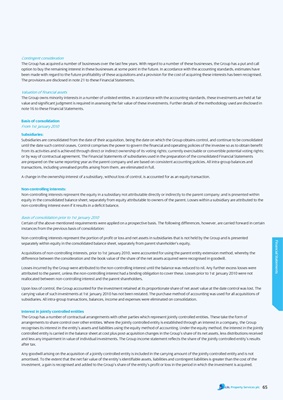
Contingent consideration
The Group has acquired a number of businesses over the last few years. With regard to a number of these businesses, the Group has a put and call
option to buy the remaining interest in these businesses at some point in the future. In accordance with the accounting standards, estimates have
been made with regard to the future profitability of these acquisitions and a provision for the cost of acquiring these interests has been recognised.
The provisions are disclosed in note 21 to these Financial Statements.
Valuation of financial assets
The Group owns minority interests in a number of unlisted entities. In accordance with the accounting standards, these investments are held at fair
value and significant judgment is required in assessing the fair value of these investments. Further details of the methodology used are disclosed in
note 16 to these Financial Statements.
Basis of consolidation
From 1st January 2010
Subsidiaries:
Subsidiaries are consolidated from the date of their acquisition, being the date on which the Group obtains control, and continue to be consolidated
until the date such control ceases. Control comprises the power to govern the financial and operating policies of the investee so as to obtain benefit
from its activities and is achieved through direct or indirect ownership of its voting rights; currently exercisable or convertible potential voting rights;
or by way of contractual agreement. The Financial Statements of subsidiaries used in the preparation of the consolidated Financial Statements
are prepared on the same reporting year as the parent company and are based on consistent accounting policies. All intra-group balances and
transactions, including unrealised profits arising from them, are eliminated in full.
A change in the ownership interest of a subsidiary, without loss of control, is accounted for as an equity transaction.
non-controlling interests:
Non-controlling interests represent the equity in a subsidiary not attributable directly or indirectly to the parent company; and is presented within
equity in the consolidated balance sheet, separately from equity attributable to owners of the parent. Losses within a subsidiary are attributed to the
non-controlling interest even if it results in a deficit balance.
Basis of consolidation prior to 1st January 2010
Certain of the above-mentioned requirements were applied on a prospective basis. The following differences, however, are carried forward in certain
instances from the previous basis of consolidation:
Non-controlling interests represent the portion of profit or loss and net assets in subsidiaries that is not held by the Group and is presented
Financial Statements
separately within equity in the consolidated balance sheet, separately from parent shareholder’s equity.
Acquisitions of non-controlling interests, prior to 1st January 2010, were accounted for using the parent entity extension method, whereby the
difference between the consideration and the book value of the share of the net assets acquired were recognised in goodwill.
Losses incurred by the Group were attributed to the non-controlling interest until the balance was reduced to nil. Any further excess losses were
attributed to the parent, unless the non-controlling interest had a binding obligation to cover these. Losses prior to 1st January 2010 were not
reallocated between non-controlling interest and the parent shareholders.
Upon loss of control, the Group accounted for the investment retained at its proportionate share of net asset value at the date control was lost. The
carrying value of such investments at 1st January 2010 has not been restated. The purchase method of accounting was used for all acquisitions of
subsidiaries. All intra-group transactions, balances, income and expenses were eliminated on consolidation.
interest in jointly controlled entities
The Group has a number of contractual arrangements with other parties which represent jointly controlled entities. These take the form of
arrangements to share control over other entities. Where the jointly controlled entity is established through an interest in a company, the Group
recognises its interest in the entity’s assets and liabilities using the equity method of accounting. Under the equity method, the interest in the jointly
controlled entity is carried in the balance sheet at cost plus post-acquisition changes in the Group’s share of its net assets, less distributions received
and less any impairment in value of individual investments. The Group income statement reflects the share of the jointly controlled entity’s results
after tax.
Any goodwill arising on the acquisition of a jointly controlled entity is included in the carrying amount of the jointly controlled entity and is not
amortised. To the extent that the net fair value of the entity’s identifiable assets, liabilities and contingent liabilities is greater than the cost of the
investment, a gain is recognised and added to the Group’s share of the entity’s profit or loss in the period in which the investment is acquired.
65